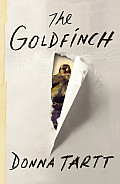 Here’s another conflict between me, the critics, and the best-seller list. My question: How to write a dull novel that begins with a terrorist explosion in the NY Met Museum of Art, traverses territory from NYC to Vegas to Europe, spans maybe a dozen years, involves stolen art, millions of dollars, and the Russian underworld?
Here’s another conflict between me, the critics, and the best-seller list. My question: How to write a dull novel that begins with a terrorist explosion in the NY Met Museum of Art, traverses territory from NYC to Vegas to Europe, spans maybe a dozen years, involves stolen art, millions of dollars, and the Russian underworld?
The answers are multifold, and they all appear in Donna Tartt‘s The Goldfinch. One clue is contained in Elmore Leonard’s rule about cutting out the parts in your draft that readers will skip. I skipped/skimmed probably a hundred pages of The Goldfinch.After he loses his mother in the aforementioned explosion, 13-year-old Theodore Decker emotionally shuts down. Psychologically accurate, but not very interesting if you’re spending every minute inside his head. Plus, he goes from his parentless home to stay in the dull and monotonous household of a friend of his. The only points of tension here are some half-hearted bullying from his schoolmates, some feckless efforts by adults to draw him out, and the painting. A small 17th century masterpiece by a Dutchman named Fabritius. His only extant work. Theo does/doesn’t want to keep it, but doesn’t know how to give it back without getting into trouble, which conflict arises periodically throughout the book. Most of the time the crisis lies dormant except when its discovery seems imminent and Decker has to hide it again.

Other than that, there’s a lot of abstruse talk about artistic technique–brushwork, use of light, composition–that does little to move the plot. The closest we come to relevance in that regard is some commentary about the tiny gold chain that fastens the finch to his perch–a possible analogy to Theo’s attachment to the painting or to his emotional dependence on his mom’s memory or to drugs. There’s quite a lot of drugstore philosophy. Take this news flash: Good results can come from bad actions and vice-versa. Then in the places where things do get interesting–such as when Theo’s con-man dad takes him from Manhattan to Vegas, then leaves him alone to engage in various clandestine activities with another neglected teen named Boris–Tartt strings things out beyond their tolerance. There’s only so much glue-sniffing, vodka-chugging, and puking you can take before it gets old. And there’s the tell-don’t-show thing. Theo turns into something of a con man himself, and we’re told he’s an excellent salesman, but we never see him in action.
To be fair–although I don’t think I’ve been unfair yet–there are brilliant moments in The Goldfinch. The whole character of Theo’s mentor/father-figure Hobie is masterful. The sequence of action in Holland involving the attempted re-purchase of the purloined painting is as exciting and compelling as anything out of the pages of a well-written thriller. The unrequited affair between Theo and the girl who was in the museum bombing with him (except that she’s–cliche on cliche–a little redheaded girl named Pippa) is touching.
I guess I could sum it up by calling The Goldfinch an uneven effort–stretches of two- and three-star pages interspersed with five-star moments. A disappointment.
